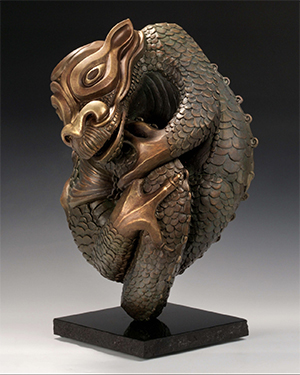The Whimsical Wildlife Bronzes of Pokey Park
Tuscon, Arizona-based Sculptor Pokey Park’s whimsical wildlife bronze works are imbued with as much personality as they are with technical precision. So, it makes perfect sense she’s been drawn to bronze since childhood.
“Bronze is a permanent material that can withstand the elements over time,” she says. “I saw reproductions of ancient Greek and Roman bronzes that had been recovered from the Mediterranean as a young child and was fascinated. They connected the distant past to the present. This is particularly important today given the turmoil in our present world. Lessons of the past should never be forgotten.”
Park’s style reflects her belief that life needs to be celebrated with whimsy and attitude.
“A sculpture I am working on never seems complete without an attitude or personality,” she says. “I use the flow of lines and surface patterns to create positive and negative spaces in my sculpture. This creates movement and balance between the parts.”
One of her most ambitious commissions was one to create 35 animal habitat sculptures for expansion of the Lucille Packard Children's Hospital at Stanford University's Medical Center in Palo Alto, CA.
The new addition has six levels. Its themes are built around the ecological regions of California and differentiate each floor level by the various flora and fauna typical of each geographical ecosystem: Rocky Shore, Redwood Forest, Valley, Desert, Foothills, Mountains.
From seals to frogs, her animal sculptures at the hospital represent the iconic themes for the different zones. And while she aimed to bring awareness to the threatened or endangered animals of each region, she had an even greater goal.
“More important was to bring joy - even for a moment - to the very sick children and their families as they deal with their health issues,” she says.
Park has won numerous awards. Most recently, the 123rd Annual Open Exhibition; Catherine Lorillard Wolfe Art Club; Harriet W. Frishmuth Memorial Award 2020. In 2019, she won the award for sculpture from Allied Artists of America.
Park attended the Taos Institute of the Arts and the University of Georgia and has a degree in fine art. Her artist expression is fueled by traveling and living in different places, she says.
“I have always been interested in disparate cultures,” says Park. “I’ve looked for cultural similarities in their myths, symbols, and beliefs. I desire to encourage unification rather than the attitude of separation that exists through fear of the unknown. One of the things I appreciate most about the remoteness of the places I’ve traveled is the openness of the people, the unspoiled landscapes and animals that inhabit them. In these remote locations there is still a possibility to discover nature at a pure balance between parts.”
Park’s curiosity forces her to observe wildlife in a natural setting - not only for the anatomy, but the mannerisms and even emotions she sees in an animal in its natural environment.
“At times, I only have a caged subject in a zoo…sometimes it's possible to adopt one to observe,” she says. Recently she acquired a bearded dragon that is indigenous to the central Australian desert that will be her newest sculpture.
Park said she looks for the underlying joy in the world to express in her sculpture.
“People do not like to see in themselves in animal traits even though we are connected in many ways,” she says. “But they are drawn to live animals that display human traits. These shared characteristics are displayed in the uninhibited play of wild animals. I love the challenge of depicting the correct anatomical details of animals in my unique style by giving them human characteristics that bring them to life in an engaging, playful manner.”
 Dragon Dreaming, bronze, 22.5" x 13.5" x 15
Dragon Dreaming, bronze, 22.5" x 13.5" x 15Photo courtesy of Pokey Park.
Park’s given name is Marie Whittle-Webb Park but her childhood nickname has stuck with her.
“When I was a young child my uncle gave me the nickname ‘Pokey’ because I would lag behind him on our nature walks, ‘poking along, needing to touch and smell each plant,” she said. The name has stuck to this day.
Park traced her love for nature and respect for its varied moods to the coastal Georgia island where she was born.
“Open skies, endless beaches, vast marshes, winding creeks, deep woods shadows were my playground,” she says. “Wild Marsh Takey horses were still roaming free and I spent endless hours following them on my own horse.”
She said she was enraptured by the light, shadows and textures of that environment.
That childhood echoes through her work.
“The sounds of silence deep in the woods were as powerful as a being in a cathedral,” she says “Such a powerful feeling to be alive and surrounded by all the beauty I felt a need to create something myself to give back.”
Resources:
Also in this Issue:
- Art Omi: Showcasing the True Nature of Sculpture
- Randolph Rose Collection: Creating Bronze Legacies that Stand the Test of Time
- The Whimsical Wildlife Bronzes of Pokey Park
- Rare 1900s Gilded Native American Weathervane Auctioned
- Rare 19th-Century Bronze Vase Designed by Thomas Hope Discovered in Oklahoma Collection
